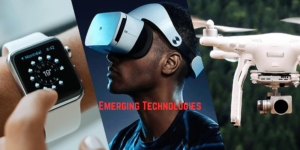In today’s rapidly evolving digital landscape, businesses must continuously innovate and adapt to maintain a competitive edge. Staying relevant requires a proactive approach to leveraging new technologies to enhance efficiency, improve customer experiences, and drive growth. Here’s an in-depth look at some emerging technologies every business should be aware of and consider integrating into their operations.
1. Artificial Intelligence (AI) and Machine Learning (ML)
AI and ML have already begun to revolutionize industries. These technologies enable systems to learn and adapt without explicit programming, making them capable of analyzing vast amounts of data to identify patterns, predict outcomes, and automate decision-making processes. Businesses can leverage AI and ML in various applications, such as personalized marketing, customer service automation, and predictive analytics, to optimize operations and enhance customer satisfaction.
Applications to Watch:
- Chatbots and Virtual Assistants: Improve customer service and engagement through AI-driven conversations tailored to individual needs.
- Predictive Analytics: Harness data to forecast trends and consumer behavior, allowing for more informed strategic decisions.
- Process Automation: Streamline operations using AI to perform repetitive tasks, liberating human resources for more creative and complex engagements.
2. Internet of Things (IoT)
The IoT ecosystem connects physical objects—from industrial machines to everyday consumer devices—to the internet, facilitating data collection and sharing. This connectivity helps businesses in various ways, from optimizing supply chains to offering revolutionary new services to consumers.
Impactful Use Cases:
- Smart Supply Chain Management: IoT sensors monitor real-time inventory levels, shipment tracking, and warehouse logistics.
- Connected Products: Enhance consumer experiences with devices like smart home appliances and wearable technology, offering increased functionality and personalization.
- Predictive Maintenance: Adopt a proactive approach to equipment maintenance, minimizing downtime and enhancing productivity.
3. Blockchain Technology
Originally developed as the foundation for cryptocurrencies like Bitcoin, blockchain technology offers more than a secure method for handling financial transactions. It provides a decentralized, transparent, and safe method for recording and verifying transactions across various sectors.
Key Business Opportunities:
- Smart Contracts: Automate and enforce contract negotiations and execution without intermediaries, reducing costs and increasing efficiency.
- Enhanced Security: Employ blockchain technologies to secure sensitive data, reducing vulnerability to hacks and breaches.
- Supply Chain Transparency: Leverage immutable ledger capabilities to increase visibility and accountability in supply chains.
4. Augmented Reality (AR) and Virtual Reality (VR)
AR and VR technologies offer transformative potential for customer interaction and engagement. By creating immersive experiences, businesses can provide innovative ways to showcase their products and services.
Innovative Implementations:
- Retail and E-commerce: Use AR for virtual try-ons, enabling customers to visualize products in real-world settings.
- Remote Collaboration: Harness VR for immersive conferencing and collaborative work environments, breaking geographical barriers.
- Training and Education: Develop interactive training modules using VR to enhance learning experiences and retention rates.
5. 5G Connectivity
As the fifth generation of mobile networking technology, 5G promises faster speeds, reduced latency, and higher capacity than its predecessors. Its deployment can significantly impact various business operations and consumer experiences.
Areas for Exploration:
- Enhanced Mobile Engagement: 5G enables more responsive and richer mobile applications, driving deeper customer engagement.
- IoT Expansion: Bolstered connectivity accelerates IoT adoption, leading to the development of more innovative and interconnected devices.
- Edge Computing: Initially, compute power was centered on large data centers. With 5G, more data processing closer to the source with edge computing becomes viable, improving response times and reducing bandwidth usage.
6. Quantum Computing
Though still in the beginning stages, quantum computing holds promise as a transformative technology. These robust computing systems can process complex datasets exponentially faster than traditional ones, offering potential breakthroughs in cryptography, optimization problems, and large-scale simulations.
Future Possibilities:
- Financial Modeling: Leverage quantum computing for risk assessments and complex economic models that go beyond classical computing capabilities.
- Pharmaceutical Research: Expedite drug discovery processes through advanced molecular modeling and simulation.
- Complex Problem Solving: Address computational challenges such as climate modeling and supply chain logistics more efficiently.
7. Robotics and Automation
Automating tasks through robotics presents a significant opportunity for industries ranging from manufacturing to service sectors. By deploying robotics, businesses can improve efficiency and reduce labor costs while ensuring higher precision and consistency.
Strategic Implementation:
- Manufacturing Automation: Adopt robotics for assembling, packing, and quality control to boost production efficiency.
- Service Robots: Deploy robots in customer service settings, from hospitality to healthcare, to perform routine tasks and allow human workers to focus on added-value activities.
- Logistics and Warehousing: Utilize automated solutions for order picking and packaging, reducing processing times and errors.
Conclusion
The pace of technological advancement presents both challenges and opportunities for businesses. By adopting these emerging technologies, organizations can improve their current operations and explore new markets and business models. As we move forward, keeping abreast of technological developments and being agile in their adoption will be crucial for maintaining a competitive advantage in the modern business landscape. Businesses that harness these emerging technologies wisely will find themselves well-positioned for future success.

